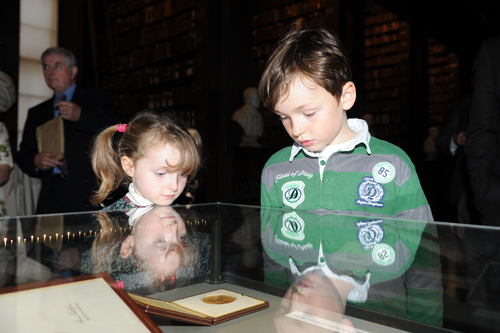TCD Exhibition Celebrates Nobel Laureate Dr Ernest Walton
Posted on: 03 November 2010
Physicist and Nobel Laureate Ernest Walton is remembered in an exhibition in the Long Room in Trinity College Dublin where his Nobel citation and medal along with personal and academic papers donated to Trinity will be on display for the first time.
Ernest Walton (1903-1995) was born in Dungarvan in County Waterford and was educated at the Methodist College in Belfast and entered Trinity College Dublin in 1922. He became a Scholar in 1923 and graduated in mathematics and physics in 1926. After a year’s postgraduate work in TCD, Walton went to study in the Cavendish Laboratory in Cambridge under the Nobel prize-winner Lord Ernest Rutherford. Working with John Cockcroft, he successfully split the nucleus of an atom in April 1932. They were subsequently jointly awarded the Nobel prize in 1951 for “their pioneering work on the transmutation of atomic nuclei by artificially accelerated atomic particles”.
Walton returned to Trinity College in 1934 where he became a fellow and the Professor of Natural and Experimental Philosophy. He was well known for his personal integrity, his commitment to the improvement of the standard of science education in Ireland, and as a compelling lecturer. In 1993 he presented his Nobel medal and citation to Trinity College Dublin along with his personal and scientific papers.

Ernest Walton’s great grandchildren, Hannah and Ben Clarke admire the Nobel Medal and exhibition
Included in the exhibition are personal papers such as a notebook that records Walton’s final-year undergraduate research in photographing rays in an expansion chamber. There is also a letter from Walton to his wife Freda Wilson. He met his wife when they were both in school in the Methodist College Belfast. They were engaged to be married during the time that he was in Cambridge and corresponded very frequently. This is the first letter that Walton sent to his fiancée after the successful experiment which occurred on 14 April 1932:
“Cockcroft and I made what is in all probability a very important discovery in the lab … It opens up a whole new field of work which may go a long way towards elucidating the structure of the nucleus of the atom.”
The exhibition also includes Freda Walton’s diary of the journey to Sweden for the Nobel prize-giving in 1951: ” … when we go home and all this pageantry has faded, that honour will last forever.”
The notebook contains a list of talks on the subject of the Nobel prize-giving which Mrs Walton gave to schools, church groups and women’s organisations upon her return. Accompanying Dr Walton during his later lecturing tours of America, Mrs Walton undertook a programme of lectures on Irish history and antiquities and the history of Methodism in Ireland. Walton’s private papers, which he presented to the Library in 1993, reveal his prescience in recognising the necessity for upgrading the standard of science research and education in Ireland, and his persistent efforts to champion this cause. He was invited by the Taoiseach Éamon de Valera (1882-1975) to submit a memorandum on the subject to the government in 1957:
“We are today entering a new scientific era and, if we are to benefit from it, our people should not be allowed to grow up scientifically illiterate.”These along with the Nobel citation and medal will be on display as part of the exhibition.
Provost Dr John Hegarty said that Trinity was deeply proud of its unique and lifelong association with one of Ireland’s greatest scientists.
“The next two years mark significant anniversaries in relation to Ernest Walton and Science. 2011 will be the 60th anniversary of the award of the Nobel Prize to Ernest Walton and John Cockroft; 2012 will be the 80th anniversary of the seminal experiment by Cockroft and Walton in Cambridge which earned them the Nobel Prize. In 2012 Dublin will have the honour of being the European City of Science, an honour that Ernest as a champion of science education would be justly proud. The coincidence of all of these dates makes it very timely to begin a series of events to commemorate Ernest Walton, the scientist, the academic, and the proud Irishman.”
